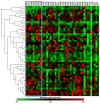Dysregulation of KRAS signaling in pancreatic cancer is not associated with KRAS mutations and outcome
- PMID: 29113235
- PMCID: PMC5661609
- DOI: 10.3892/ol.2017.6946
Dysregulation of KRAS signaling in pancreatic cancer is not associated with KRAS mutations and outcome
Abstract
Pancreatic ductal adenocarcinoma (PDAC) is a tumor with a poor prognosis, and no targeted therapy is currently available. The aim of the present study was to investigate the prognostic significance of the expression of V-Ki-ras2 Κirsten rat sarcoma viral oncogene homolog (KRAS), downstream signaling pathway genes and the association with clinical characteristics in PDAC patients undergoing radical surgery. Tumors and adjacent non-neoplastic pancreatic tissues were examined in 45 patients with histologically verified PDAC. KRAS and B-Raf proto-oncogene, serine/threonine kinase (BRAF) gene mutation analysis was performed using the KRAS/BRAF/phosphatidylinositol-4,5-bisphosphate 3-kinase catalytic subunit α array. The transcript profile of 52 KRAS downstream signaling pathway genes was assessed using quantitative-polymerase chain reaction. KRAS mutation was detected in 80% of cases. The genes of four signaling pathways downstream of KRAS, including the phosphoinositide 3-kinase/3-phosphoinositide-dependent protein kinase 1/V-akt murine thymoma viral oncogene homolog 1, RAL guanine nucleotide exchange factor, Ras and Rab interactor 1/ABL proto-oncogene-1, non-receptor tyrosine kinase, and RAF proto-oncogene serine/threonine-protein kinase/mitogen-activated protein kinase pathways, exhibited differential expression in PDAC compared with that in the adjacent normal tissues. However, no significant differences in expression were evident between patients with KRAS-mutated and wild-type tumors. The expression of KRAS downstream signaling pathways genes did not correlate with angioinvasion, perineural invasion, grade or presence of lymph node metastasis. Additionally, the presence of KRAS mutations was not associated with overall survival. Among the KRAS downstream effective signaling pathways molecules investigated, only v-raf-1 murine leukemia viral oncogene homolog 1 expression was predictive of prognosis. Overall, KRAS mutation is present in the majority of cases of PDAC, but is not associated with changes in the expression of KRAS downstream signaling pathways and the clinical outcome. This may partly explain the failure of KRAS-targeted therapies in PDAC.
Keywords: KRAS; gene expression; mutation; overall survival; pancreatic ductal adenocarcinoma.
Figures




References
LinkOut - more resources
Full Text Sources
Other Literature Sources
Research Materials
Miscellaneous
